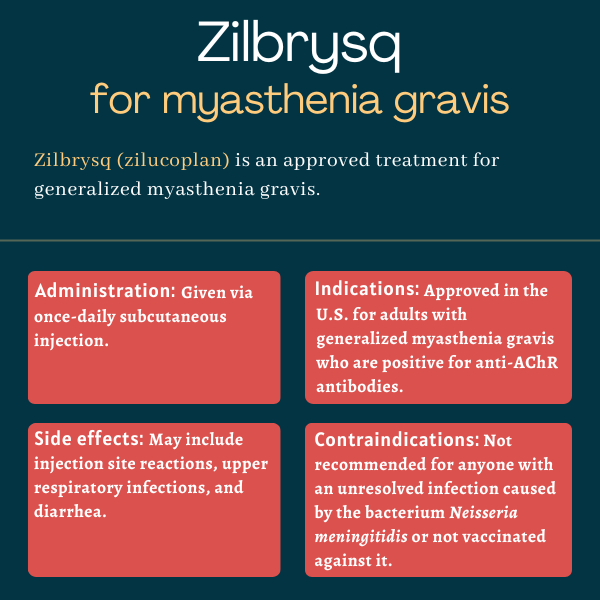Zilbrysq (zilucoplan) for myasthenia gravis
What is Zilbrysq for myasthenia gravis?
Zilbrysq (zilucoplan) is a complement inhibitor that’s approved to treat adults with generalized myasthenia gravis (gMG) who are positive for antibodies targeting the acetylcholine receptor (AChR), the most common type of MG-driving antibody.
The therapy, given once daily via subcutaneous or under-the-skin injections, is marketed by UCB. It’s the only treatment in its class to be approved in the U.S. for this condition that can be self-administered, at home.
Therapy snapshot
| Brand name: | Zilbrysq |
| Chemical name: | Zilucoplan |
| Usage: | Treatment of generalized myasthenia gravis |
| Administration: | Once-daily subcutaneous injection |
How does Zilbrysq work?
Myasthenia gravis (MG) is driven by self-reactive antibodies that interfere with the communication between nerve and muscle cells, ultimately giving rise to symptoms of muscle weakness and fatigue. The most common type of MG-driving antibodies target the AChR protein, which plays a key role in this process.
When an antibody binds to AChR, it can trigger the activation of the complement system, which encompasses a group of immune proteins found in the blood. Normally, antibodies target infectious invaders like bacteria, and the activation of the complement system helps eliminate disease-causing agents. But in MG, where antibodies are targeting healthy parts of the body, complement activation acts as a driver of the disease.
Zilucoplan, the active agent in Zilbrysq, is a small, artificial molecule that works to block the activation of the complement cascade. It is specifically designed to target a complement protein called C5.
When complement is activated, the C5 protein is normally split into two components (C5a and C5b), which form complexes with other complement proteins to drive a powerful inflammatory reaction. By preventing C5 from being split, Zilbrysq is expected to reduce the damaging immune reaction driven by complement activation in MG.
Who can take Zilbrysq?
Zilbrysq was approved by the U.S. Food and Drug Administration (FDA) in October 2023 as a treatment for adults with generalized MG who are positive for anti-AChR antibodies. With that decision, Zilbrysq became the first once-daily self-injectable complement targeted therapy available to treat gMG in the U.S.
The therapy is only available in the U.S. through a restricted risk evaluation and mitigation strategy (REMS) program called Zilbrysq REMS due to the risk of serious meningococcal infections associated with the treatment. Patients must be carefully monitored for signs of meningococcal infections, a bacteria-based illness, as these can become rapidly life-threatening or fatal if not detected and treated early.
Zilbrysq is also approved in Japan for adults with gMG who failed to respond adequately to other treatments, like steroids.
It has also been approved in Europe in December 2023 as an add-on to standard therapy for the treatment of adults with gMG who are positive for anti-AChR antibodies.
Who should not take Zilbrysq?
Zilbrysq is contraindicated, or not recommended, for anyone who has an unresolved infection with the bacterium Neisseria meningitidis, which causes a serious illness called meningococcal disease.
The therapy also should not be administered to patients who aren’t vaccinated against Neisseria meningitidis, unless the risks of delaying treatment outweigh the potential risk of a meningococcal infection.
How is Zilbrysq administered?
Zilbrysq is given by injection under the skin, and can be administered into areas of the abdomen, thighs, or the back of the upper arms.
The therapy is available in pre-filled syringes at one of three doses, each packaged with a plunger of a different color. Its recommended daily dose is based on a patient’s body weight:
- The lowest dose, of 16.6 mg, is packaged with a red plunger, and is for patients weighing less than 56 kg (about 123.5 pounds).
- The 23 mg dose, packaged with an orange plunger, is for patients weighing 56 kg to less than 77 kg (about 123.5 pounds to 170 pounds).
- The highest dose, of 32.4 mg, is packaged with a blue plunger, and is for patients weighing more than 77 kg (about 170 pounds).
The syringes may be stored at room temperature or in the refrigerator. If stored in the refrigerator, the medication should be allowed to reach room temperature before being injected. Zilbrysq should not be returned to the refrigerator after being kept at room temperature.
Zilbrysq is administered once daily via subcutaneous injection. The skin areas used for the injection should not have any tenderness, redness, bruising, scarring, or irritation. Injection sites should be rotated with each administration.
The medication should be given under the supervision of a healthcare professional, but with appropriate training, Zilbrysq can be given by caregivers or self-administered by patients. Caregivers should give Zylbrisq injections in the upper outer arm.
If a dose of Zilbrysq is missed, the next dose should be given as soon as possible, with subsequent doses given once daily. Importantly, Zilbrysq injections should never be administered more than once per day.
Zilbrysq in clinical trials
Zilbrysq’s approvals in the U.S. and elsewhere were supported by data from a Phase 3 clinical trial called RAISE (NCT04115293), completed in 2021.
RAISE trial
RAISE enrolled 174 adults with AChR-positive gMG. Participants were randomly assigned to receive once-daily subcutaneous injections of either Zilbrysq, at a dose of 0.3 mg/kg, or a placebo, for a period of 12 weeks, or about three months.
The trial’s main goal was to evaluate the effect of treatment on the score of the MG Activities of Daily Living (MG-ADL), a standardized measure of MG symptom severity and the impact of the disease on patients’ daily lives. MG-ADL scores can range from 0 to 24, with higher values indicating worse symptoms and higher impairment.
Results showed that, at week 12, nearly three-quarters (73.1%) of patients given Zilbrysq experienced a clinically significant improvement of at least three points on the MG-ADL. By comparison, less than half (46.1%) of the patients given a placebo saw a meaningful improvement in MG-ADL scores.
At week 12, MG-ADL scores had dropped by a a mean of 4.39 points from the study’s start in Zilbrysq-treated patients, and by 2.30 points in patients given a placebo — a difference of 2.09 points favoring Zilbrysq.
Similarly, more than half (58%) of the patients treated with Zilbrysq had a clinically significant improvement of at least five points on the Quantitative MG (QMG) score, a standardized clinician-reported measure of MG severity. By comparison, only 1 in 3 patients (33.3%) on the placebo achieved the same outcome.
QMG score reductions over the course of the study also were more accentuated in patients given Zilbrysq than in those given a placebo. Specifically, Zilbrysq-treated patients saw their scores drop by nearly three more points at week 12 than those given a placebo.
Measures of life quality and fatigue also generally favored Zilbrysq over the placebo.
Subgroup analyses suggested the effects of Zilbrysq were similar across patients regardless of sex, age, disease duration, or prior treatments. The presence of a thymoma, or a thymus tumor, did not affect the results.
Analyses from the 16 trial participants who were Japanese also showed comparable findings to the overall study population, which mainly comprised white individuals.
Ongoing trials
Patients who completed RAISE or other Zilbrysq clinical trials had the option to enroll in an ongoing open-label extension, called RAISE-XT (NCT04225871). In the extension, all participants are being treated with Zilbrysq and being monitored for long-term outcomes. This study is expected to wrap up in 2026.
Interim data from 199 patients who enrolled in the extension study showed that about three-quarters experienced clinically meaningful improvements on MG-ADL and QMG scores within the first 12 weeks of RAISE-XT. No new safety issues were reported.
Common side effects of Zilbrysq
The most common side effects of Zilbrysq reported in gMG patients were:
- injection site reactions
- upper respiratory tract infections
- diarrhea.
Infections
Zilbrysq is designed to block the activity of the complement cascade, a part of the immune system that normally helps to defend the body against infectious agents. Like other complement-blocking medications, Zilbrysq may increase the risk of infections.
The treatment carries a boxed warning for serious meningococcal infections, a type of bacterial infection that has been observed in people given similar complement-blocking medicines. Such infections can rapidly become life-threatening or fatal if not identified and treated early.
At least two weeks before starting treatment with Zilbrysq, patients should receive all recommended vaccinations to protect against meningococcal infections, unless the risks of delaying treatment outweigh the potential risk of an infection. In situations where Zilbrysq needs to be started urgently in patients who haven’t yet received these vaccines, prophylactic, or preventive, anti-bacterial medications should be given, and the recommended vaccines administered as soon as possible.
Infections may still occur, even in people who are vaccinated. Thus, patients on Zilbrysq also should be routinely monitored for signs of possible meningococcal infections.
Zilbrysq also may increase patients’ susceptibility to other types of infections, including those caused by encapsulated bacteria, such as Streptococcus pneumoniae, Haemophilus influenzae, and Neisseria gonorrhoeae. It’s recommended that patients be vaccinated to prevent infections caused by these bacteria.
Pancreas inflammation and other issues
Pancreatitis, or pancreas inflammation, and pancreatic cysts, which are fluid-filled growths in the pancreas, have occurred in patients given Zilbrysq. Markers of pancreas health (lipase and amylase) should be evaluated before patients start taking Zilbrysq.
If patients show signs of pancreatitis, Zilbrysq should be stopped until pancreas issues have been ruled out or resolved with appropriate treatment.
Use in pregnancy and breastfeeding
There are no adequate studies on the use of Zilbrysq in people who are pregnant or breastfeeding. In animal studies done in monkeys, the use of Zilbrysq during pregnancy led to an increased risk of death for the developing fetus.
It’s also not known if Zilbrysq can be found in breast milk, and whether it has any impact on nursing infants or on milk production.
The decision of whether or not to use Zilbrysq during pregnancy or breastfeeding should be discussed between patients and their healthcare providers, taking into account the potential benefits and risks of the medication.
Myasthenia Gravis News is strictly a news and information website about the disease. It does not provide medical advice, diagnosis, or treatment. This content is not intended to be a substitute for professional medical advice, diagnosis, or treatment. Always seek the advice of your physician or other qualified health provider with any questions you may have regarding a medical condition. Never disregard professional medical advice or delay in seeking it because of something you have read on this website.
Recent Posts
Related articles

 Fact-checked by
Fact-checked by 





